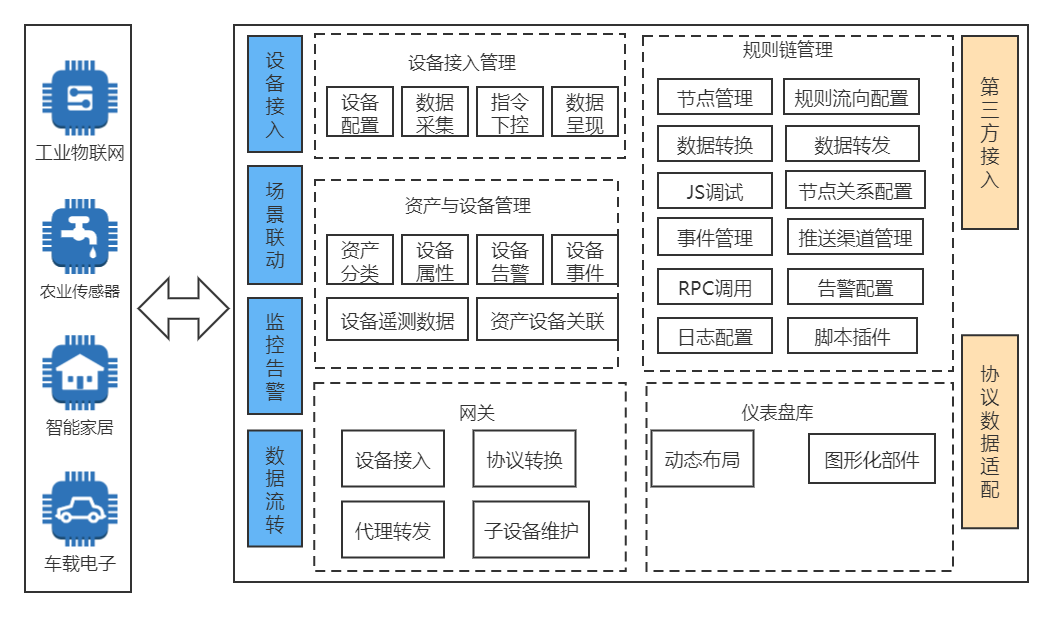

Smart home, smart healthcare, smart city, smart environmental protection, smart transportation, smart agriculture, smart logistics, smart security, etc.

The Supervisory Control and Data Acquisition (SCADA) solution originated from the needs for industrial automation, especially for remote operation, real-time data monitoring, and process control. The SCADA system uses network communication technology, real-time database, human-machine interface (HMI) and other technologies to realize real-time monitoring and control of industrial equipment with the help of the sensors and actuators.
The core functions of the SCADA system include data acquisition, real-time monitoring, event alarm, trend analysis, remote control, and automated script execution. These capabilities, enabled by integrated software platforms and hardware devices, provide enterprises with a centralized management interface to monitor and control disparate assets and processes.
For industries such as manufacturing, oil and gas, and power supply, the data acquisition and monitoring control system solves the problems of untimely equipment status monitoring, slow fault response, low production efficiency, and high operating costs. Through real-time data collection and analysis, the SCADA system can predict and prevent equipment failures, optimize production processes, improve energy efficiency, reduce maintenance costs, and improve overall operational efficiency and reliability.

1. Convenient operation: The SCADA system provides an intuitive user interface, making device management and rule configuration simple and fast. Users can easily add, configure and monitor devices through a graphical interface without the need for in-depth knowledge of complex programming or command-line operations, greatly reducing operational difficulty and training costs.
2. Efficient processing: The SCADA system is designed to take into account the needs of large-scale deployment, and the ability to connect and manage millions of devices, and process petabytes of massive data. Through an efficient data processing architecture and powerful server clusters, it ensures real-time performance and stability, meeting the data monitoring and analysis needs of large enterprises.
3. Closed-loop support: The SCADA system enables full-life-cycle management of equipment from procurement, use, maintenance, to decommissioning. Via the integrated functions such as asset management, fault prediction, and maintenance scheduling, it helps enterprises optimize equipment utilization, extend equipment lifespan, and reduce operational costs.
4. Multi-level equipment: The SCADA system supports the management of multi-level equipment systems, adapts to the diversified business needs from individual device networks to complex equipment networks. It enables unified monitoring and management of devices across different levels and types, providing flexible device organizational structures and data views.
5. Seamless integration with data asset management platform: The SCADA system achieves seamless integration with the existing enterprise data asset management platforms through standard interfaces and protocols, such as OPC UA, RESTful API, etc., ensuring data consistency and accessibility and simplifying the data integration and migration process.
6. Supporting multiple IoT protocols: The platform comes with built-in support for various IoT communication protocols, including MQTT, NB-IoT, and ModBus, to meet the connection needs of different devices and scenarios. This facilitates easy integration of existing devices and accelerates the implementation of IoT projects for enterprises.
7. Powerful rule chain management mechanism: The SCADA system provides powerful rule chain management functions, allowing users to customize complex data processing and event response rules according to business logic. It supports operations such as condition-based triggering, data filtering, and event correlation, enabling the system to flexibly adapt to various business scenarios and enhance automation levels.


Microservices architecture: Services are categorized into five types, which can be deployed independently, and loosely coupled.
Integrated Websocket real-time data transmission: Real-time display of telemetry data and property data.
Multi-protocol support: Provides support for MQTT, HTTP, CoAP and other protocols.
Zookeeper distributed lock: Implements distributed locking based on Zookeeper.
Actor model: Features high concurrency and high fault tolerance.

The SCADA system provides comprehensive equipment and data management to achieve a data-driven foundation. At the same time, the system has built a perception system that includes functions such as sorting out the device assets and business needs, constructing the device management and data processing, thereby realizing the value addition of data.

Equipment management and monitoring: Enterprises can achieve centralized access management of production equipment, including tracking every aspect of equipment from installation, commissioning, operation to maintenance and decommissioning. The real-time status monitoring function can promptly capture device operation parameters and abnormal conditions, helping maintenance teams quickly locate and resolve issues. It also enables intelligent scheduling of device operations based on equipment status and production needs, optimizing production processes and enhancing overall production efficiency.
Production data acquisition and processing: With the help of sensors and instruments, the system collects real-time environmental data, device operational status, and critical production process data, such as equipment operation parameters, production output, energy consumption, and quality inspection results. The system can quickly process and visualize these massive data, and transform the raw data into information that can be used for decision-making support through built-in data analysis tools. In addition, the data storage function provides the basis for analysis and trend forecasting of the historical data, helping enterprises to optimize production processes and improve the level of production intelligence.
Application services: In the production monitoring center, the SCADA system realizes real-time query of production data, providing operators with a real-time view of equipment status, production progress and performance indicators. The system's message release and subscription mechanism ensures that critical information is promptly communicated to relevant personnel, enhancing cross-departmental communication and collaboration. Through data analysis services, the system conducts in-depth analysis of the large amount of data collected to identify production bottlenecks and potential risks. Additionally, the system's historical data storage and playback functionality facilitates incident tracing and experience accumulation, enhancing the enterprise's control over production processes and response speed.

Guangte Electric Data Acquisition and Monitoring Control System Project
Sweet Night Data Acquisition and Monitoring Control System Project